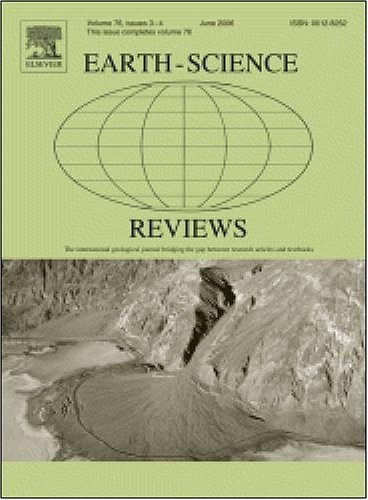古元古代(约2.3 Ga) Gowganda组:深水,冰川影响的碎屑和相关的沿被动边缘的物质流
IF 10.8
1区 地球科学
Q1 GEOSCIENCES, MULTIDISCIPLINARY
引用次数: 0
摘要
加拿大安大略省北部休伦超群的高干达组(约2.3 Ga)是世界上保存最完整的古元古代冰川环境地层记录。下Gowganda被认为是冰川期的“雪球地球”事件,尽管人们对其起源、古构造和古地理环境以及古纬度的看法不一。本研究利用以往野外调查的大型数据库以及新的沉积学、构造和盆地分析数据,表明Gowganda相记录了冰川影响的、水下的、重力驱动的深水质量流过程。下戈干达组以百米厚的厚层状到块状、乱层状和级配的双晶岩组合单元为主。它还包含厚(50米)的区域广泛的层状泥岩单元(“层状岩”),少量的主要是鹅卵石级的孤石,以及互层的级配砂岩和砾岩。我们将二晶岩相解释为由下坡水下混合大量不稳定的冰川形成的砾石、砂和泥形成的碎屑。层状岩是一种远端浊积岩,具有稀疏的冰筏状落石和邻近泥石流的跑流碎屑。层间块状和级配砾岩和砂岩被认为是盆地边缘冰川河沉积或近岸沉积的滑塌和再沉积形成的浊积岩;碎屑形态和岩性与双晶岩相同,这是在深水斜坡基底环境中与泥浆再混合形成厚的区域性双晶岩的关键证据。冰接触,盆地边缘沉积物未保存。在沉积学和古构造学上,高干达组与新元古代的冰川影响序列有明显的相似之处,这表明在大陆分裂期间冰川沉积被回收并集中到演化的裂谷中以及随后的被动边缘的沉积环境是共同的。我们强调基底断裂和冰川侵蚀在创造重要的和不断演变的古地形起伏方面的持续作用,从而导致地层厚度的显著变化。我们的结论是,在Kenorland分裂期间,冰川沉积物被重力重新加工并沿着最近裂陷的上克拉通的构造活跃被动边缘保存。与现代隆升的被动基底边缘(如挪威海岸)相邻的更新世冰川沉积是一个合适的构造-沉积类比。本文章由计算机程序翻译,如有差异,请以英文原文为准。
The Paleoproterozoic (c. 2.3 Ga) Gowganda Formation: Deep water, glacially-influenced debrites and related mass flow along a passive margin
The Gowganda Formation (ca. 2.3 Ga) of the Huronian Supergroup in Northern Ontario, Canada is the best-preserved stratigraphic record of a Paleoproterozoic glaciogenic environment in the world. The Lower Gowganda has been ascribed to a putative panglacial ‘Snowball Earth’ event despite little agreement as to its origins, paleotectonic and paleogeographic setting, and paleolatitude. The present study leverages a large database of previous field investigations with new sedimentological, structural and basin analysis data that shows that Gowganda facies record glacially-influenced, subaqueous, gravity-driven mass flow processes in deep water. The Lower Gowganda Formation is dominated by hundred-meter thick amalgamated units of thickly-bedded to massive, chaotically-bedded and graded diamictites. It also contains thick (>50 m) regionally extensive laminated mudstone units (‘laminites’) with a small number of mostly pebble-grade lonestones, and interbedded graded sandstone and conglomerates. We interpret diamictite facies as debrites formed by downslope subaqueous mixing of large volumes of unstable glacially-derived gravel, sand, and mud. Laminites are distal turbidites with sparse ice-rafted drop stones and outrunner clasts from adjacent debris flows. Interbedded massive and graded conglomerates and sandstones are identified as turbiditic deposits resulting from slumping and resedimentation of basin margin glaciofluvial or nearshore deposits; clast shapes and lithologies are the same as those in diamictites which is key evidence for remixing with mud during mass flow to generate thick regionally-extensive diamictites in a deep water base-of-slope setting. Ice contact, basin margin sediments were not preserved. There are clear sedimentological and paleotectonic parallels between the Gowganda Formation and glacially-influenced successions of younger Neopreoterozoic age indicating a commonality of depositional environments where glaciogenic sediment was recycled and focussed into evolving rifts during continental breakup and along succeeding passive margins. We emphasize the ongoing role of both basement faulting and glacial erosion in creating significant and evolving paleo-topographic relief, giving rise to marked variations in stratal thickness. We conclude that glaciogenic sediments were reworked by gravity and preserved along the tectonically-active passive margin of a recently-rifted Superior Craton during the breakup of Kenorland. Pleistocene glaciogenic sedimentation adjacent to modern uplifted passive basement margins, such as the coast of Norway, is an appropriate tectono-sedimentary analog.
求助全文
通过发布文献求助,成功后即可免费获取论文全文。
去求助
来源期刊

Earth-Science Reviews
地学-地球科学综合
CiteScore
21.70
自引率
5.80%
发文量
294
审稿时长
15.1 weeks
期刊介绍:
Covering a much wider field than the usual specialist journals, Earth Science Reviews publishes review articles dealing with all aspects of Earth Sciences, and is an important vehicle for allowing readers to see their particular interest related to the Earth Sciences as a whole.
 求助内容:
求助内容: 应助结果提醒方式:
应助结果提醒方式:


